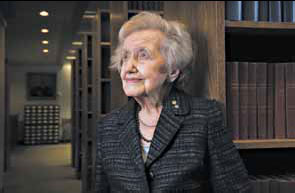Still charting the depths of memory at 94
Updated: 2013-06-02 08:02
By Claudia Dreifus(The New York Times)
|
|||||||
|
Brenda Milner showed that memory is rooted in biology. Yannick Grandmont for The New York Times |
MONTREAL - In many ways, the Obama administration's recently announced plan to map the human brain has its origins in the work of Brenda Milner, the neuropsychologist whose detailed observations of an amnesia patient in the 1950s showed how memory is rooted in specific regions of the brain.
Prior to Dr. Milner's research many scientists had abandoned biology in the study of memory, the Nobel laureate Dr. Eric Kandel wrote in his memoir, "In Search of Memory." "Milner's work changed all that."
The amnesia patient, Henry Molaison (known during his lifetime only as H.M., to protect his privacy), died at 82 in 2008; his brain is being dissected and digitally mapped in detail.
Dr. Milner, 94, still works full days, studying left/right brain differences at the Montreal Neurological Institute and Hospital. We spoke here and at the annual meeting of the American Association for the Advancement of Science in Boston. This is an excerpt of the conversations.
Q.How did you come to work with H.M., perhaps the most famous patient in neuroscience?
A.In 1950, I went to work here at the Montreal Neurological Institute to study the patients of Dr. Wilder Penfield. He'd created the Neuro as a place to pioneer the neurosurgical treatment of epilepsy. He'd developed a procedure for patients who were having epileptic seizures because of brain injuries where he'd excise the injured part of the brain.
One of the things I did was to try to help Dr. Penfield pinpoint where the seizures were coming from. This was really detective work. I used EEGs and developed tests based in part on research I was doing.
We saw two patients, P.B. and F.C., who presented with something we'd never seen before. After their surgery, their ability to form long-term memory was gone - though their immediate memory and intelligence remained intact. Dr. Penfield and I hypothesized that there was damage on one side of the brain that we couldn't have seen, and when he excised the other side he deprived these patients of the function of the region. We then wrote that theory up and presented it in an abstract to a meeting of the American Neurological Association in Chicago.
Q.Did that lead to your meeting H.M.?
A.Dr. William Scoville, a surgeon in Hartford, telephoned and said, "I'm seeing the same thing in an epileptic patient on whom I carried out an operation." Dr. Scoville then invited me to come to Hartford to study this person.
Q.What was H.M. like?
A.He'd had really terrible epilepsy ever since a childhood bicycle accident, and the surgery had been beneficial for that. But the excision had made it difficult for him to acquire new long-term memories.
There were things about the past he recalled, but he'd tell you the same joke over and over again, never remembering he'd told it to you earlier.
I would give him tests where he had to repeat a set of numbers - 5, 8, 4. He could do it by constantly repeating those numbers to himself or making up formulas. Yet, if I distracted him - and life is constantly distracting - he could no longer give you 5, 8, 4.
Q.What kinds of tests did you give him?
A.One was a puzzle where he had to trace his way out of a maze. He just couldn't do it. A different one involved giving him a five-pointed star and asking him to trace its outlines while looking in a mirror. This looks easy, but is not. This is really a test for motor-skill learning. Well, H.M. did it!
As H.M. tried tracing the star - over 30 times in a three-day period - he showed a beautiful learning curve. He couldn't recall any of the 30 tries, but he got better.
Q.What did that mean?
A.That there are different kinds of learning and that autobiographic memory, or long-term memory, isn't the whole of memory.
Q.You are 95 and you still work.
A.I'm 94! And, yes, I do work. I've always been interested in how the two sides of the brain work, and now, with functional M.R.I., we can see so much more.
Q.How's your memory?
A.Oh, it's terrible. You forget things - names. But fortunately, I've discovered that there are quite a lot of people, not only people my age, who forget names.
The New York Times
(China Daily 06/02/2013 page11)
